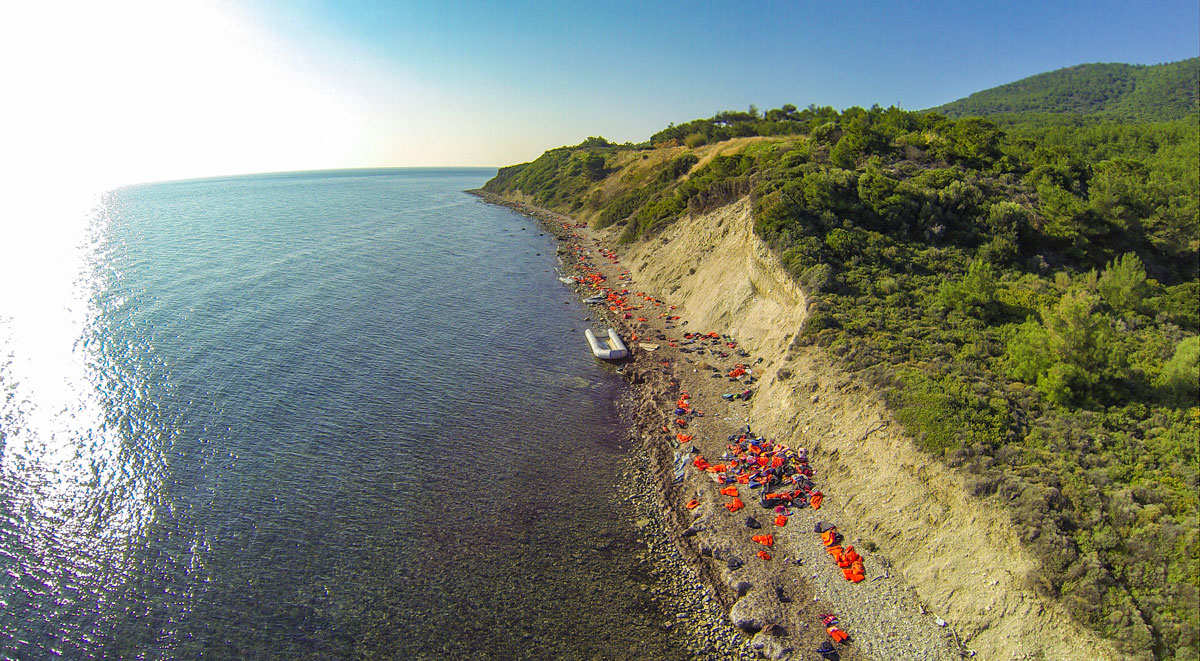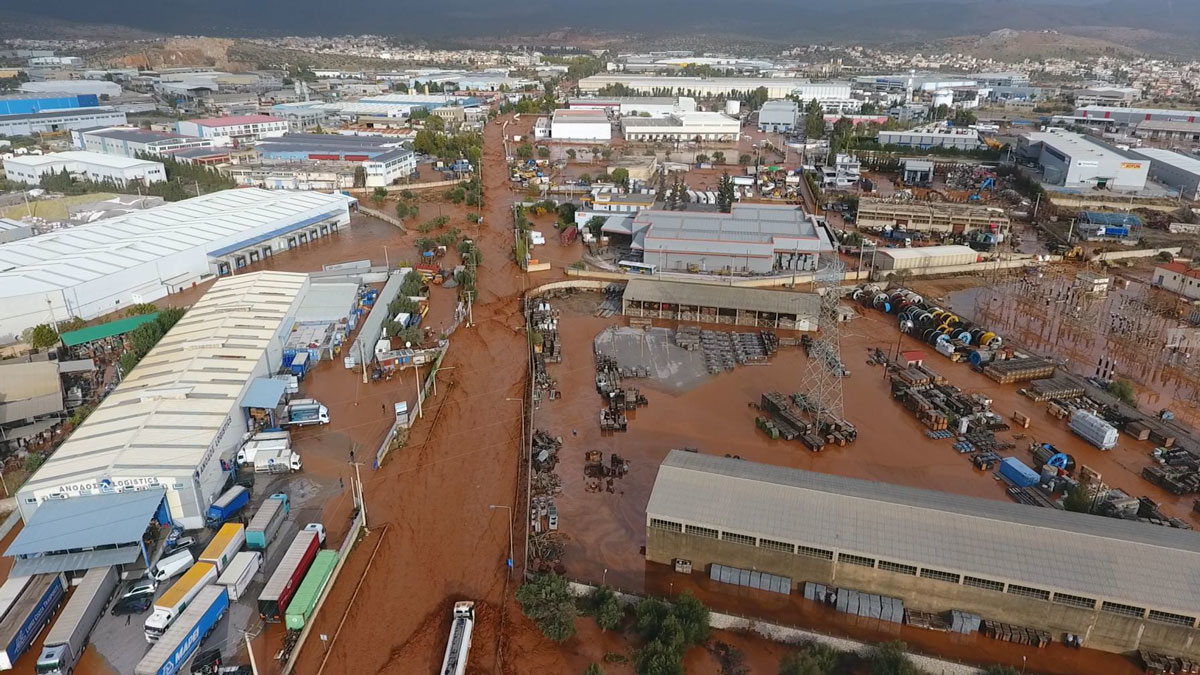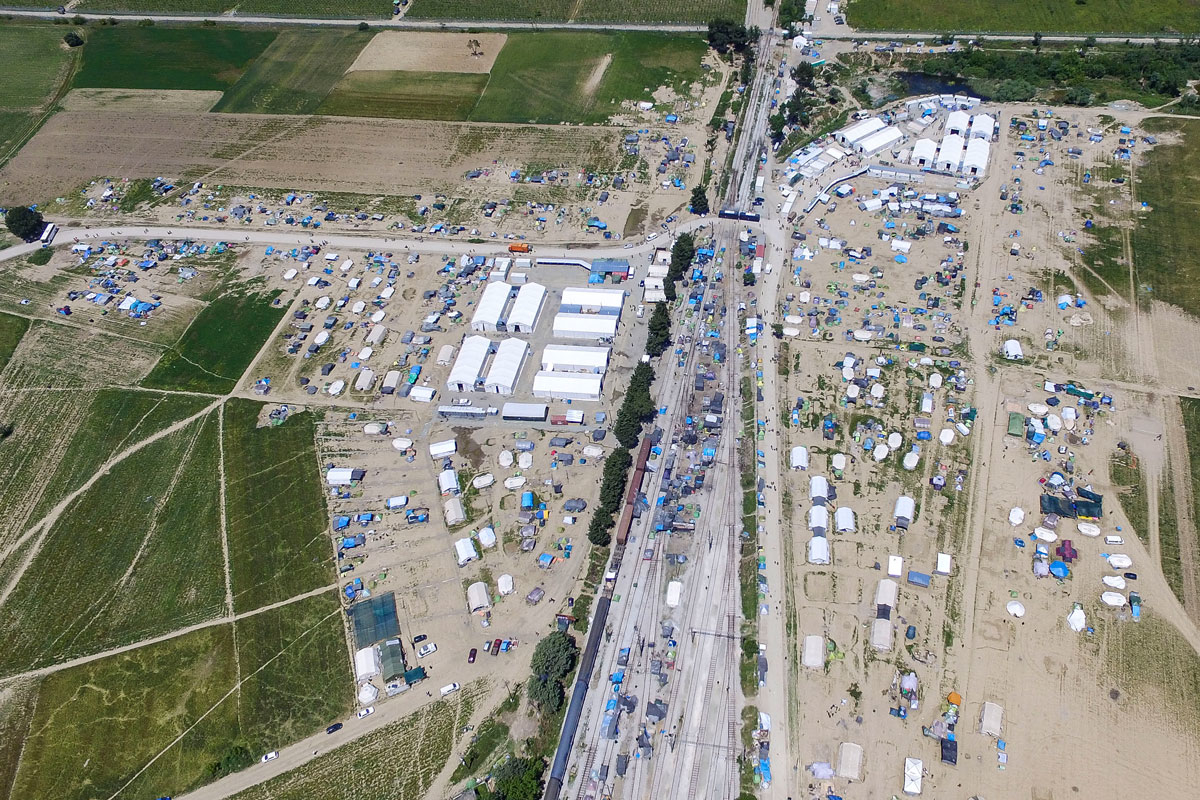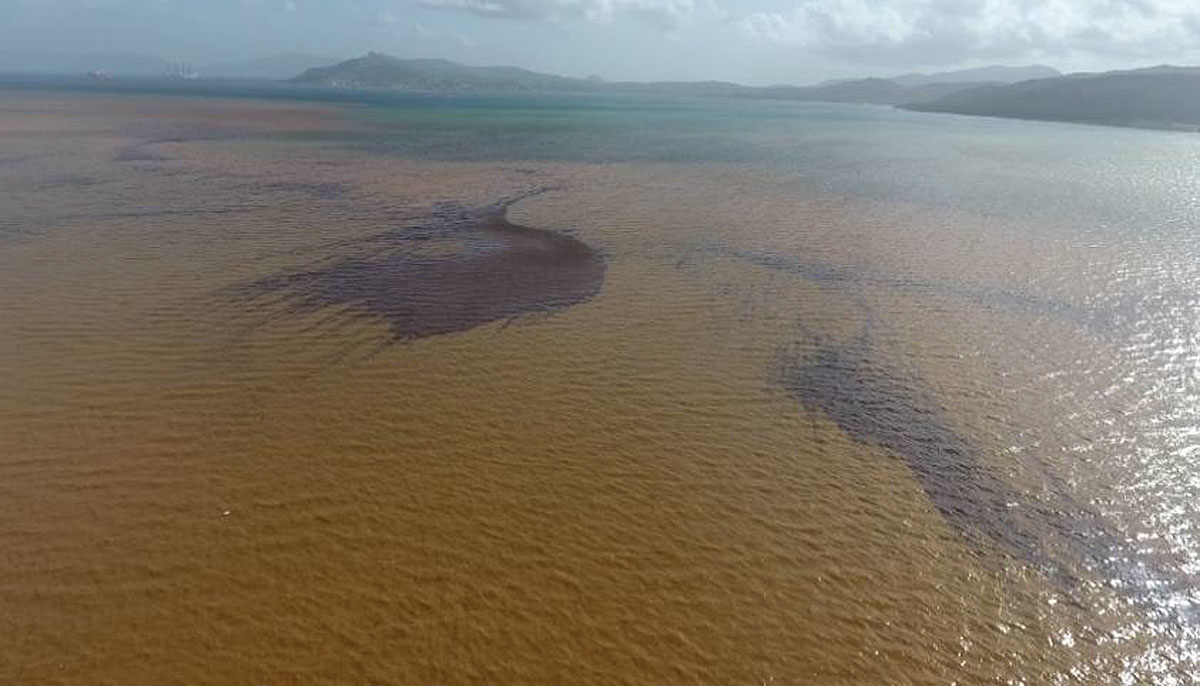
Figure 1 Searching for shipwrecked refugees on a Greek island, 2017. © Nicolas Economou.
DOI: https://doi.org/10.4414/smw.2019.20065
In April 1906, a major earthquake and the more than 30 fires that followed devastated the city of San Francisco [1]. Just a few weeks after the earthquake, a professional photographer named George Lawrence realised that he could use the technology of his era to document the size of the damage. Using a 22-kg camera elevated to approximately 600 m above the ground with a series of kites, he captured his photograph “San Francisco in Ruins”, which is world-renowned for its size and clarity. Almost a century later, another massive earthquake, of magnitude 7.0 on the Richter scale, ravaged the Haitian capital of Port-au-Prince in January 2010. In Haiti, for the first time in the history of disaster response, drones were used to collect aerial imagery of the severely affected areas [2–4].
The United Nations Secretary General’s 2016 “Agenda for Humanity” states that, in order to deliver collective outcomes, the humanitarian sector must promote a strong focus on innovation [5]. The idea of drone use for medical and humanitarian purposes is relatively new (fig. 1). As an emerging concept, the use of drones for humanitarian aid is surrounded by controversy, having gained both enthusiasts and opponents. On the one hand, hopes are very high that drones will provide extraordinary help to emergency response teams, allowing them to act faster and more effectively during crises though mapping capabilities, risk surveillance and even small loads deliveries [2, 6]. On the other hand, critics are concerned about the real value of this technology. One of the issues highlighted is the possible association of a humanitarian aim and activities with military purposes [7, 8].

Figure 1 Searching for shipwrecked refugees on a Greek island, 2017. © Nicolas Economou.
A key factor determining the success of search and rescue missions is the possibility of a fast, visual survey of the situation from altitude [3, 8, 9] (fig. 2). There are many cases of natural disaster victims being surrounded by extremely severe and inhospitable conditions. These factors alone render rescue missions time-consuming and highly demanding for both rescuers and their technological equipment. Apart from tracking victims of natural disasters or accidents, drones can be deployed for light cargo deliveries to isolated victims located in remote or out-of-reach areas. Using GPS (Global Positioning System) technology, the exact geographical location of an identified element can be instantly transmitted to the headquarters of a rescue operation [11].

Figure 2 Scanning the industrial zone of west Athens after the lethal floods of Mandra (2017). From reference [10].
Visual data collected by drones can guarantee higher safety standards for operation crews. While the earthquake in Haiti in 2010 paved the way for this, the one in Nepal five years later set the ultimate example of “best practices”. By involving drones and smartphone manufacturers, mapping software experts and Kathmandu University students were able to enlist drones to help in one of the most affected communities. After printing out huge aerial maps, the staff called out for help from the village’s residents. They were asked to share their valuable local knowledge of their region to help locate safe sources of drinking water, dangerous debris, displaced people, ruined buildings and transportations networks [3].
Once somebody gets trapped in debris after an earthquake, it is estimated that their probability of survival decreases day by day. A wide range of different approaches have been proposed, and different types of equipment have been tested. An innovative method uses a number of sensors which are easily mounted on drones. Developed by NASA researchers, this system is called “NASA’s Finding Individuals for Disaster and Emergency Response radar detector (FINDER)”. It is actually a robot with ultra-sensitive sensors that detect the heart rates and breathing patterns of a living being under rubble [12]. Due to severe socioeconomic inequalities around the world, it is easy to predict that the underprivileged parts of the world are more extensively and seriously affected by such disasters. According to Dr Marie-Paule Kieny (Assistant Director of General Health Systems and Innovation, World Health Organization), there are fewer people worldwide who have access to improved sanitation facilities than those who own a mobile phone. In another proposed system, a drone with special antennas and sensitive receivers scans the ruins for mobile phone transmissions, and once located, it pinpoints their location on digital maps.
The use of drones to deliver medicines (defibrillators, blood products, etc.) can prove crucial for both survival and improvement of daily living conditions [13–15]. Diabetes is one condition that demands instant intervention. Instead of losing valuable time waiting for an ambulance or during transportation through city traffic, a drone delivery service could send a glucose shot directly to the location of the patient within a few minutes. Another, similar scenario could be imagined in a rural part of a developing country in sub-Saharan Africa. A vast number of people in developing countries remain trapped during seasons of heavy rain. With severe weather conditions, the roads remain unpassable for days or even months, and people are cut off from medicines. A similar case is Papua New Guinea in the Pacific, which is plagued by some of the world’s highest rates of tuberculosis. There are drones have successfully been used for carrying microbiological samples, vaccines and medications to rural and remote areas [16].
The correlation of drone use with military activities raises multiple moral dilemmas [17–19]. Given the controversy that surrounds drones, along with the moral dilemmas they raise, a considerable number of humanitarian organisations and international NGOs are possibly excluding them from missions inside war zones and conflict areas [17]. In 2014, the United Nations Office for the Coordination of Humanitarian Affairs (OCHA) published an Occasional Policy Paper under the title Unmanned Aerial Vehicles in Humanitarian Response. This report clearly stated that “the use of UAVs in conflict settings is still too complex and hard to separate from military uses.” [2, 20] A rough summary of the issues relating to drone use in conflict areas could be summarised as: (i) It is very difficult if not impossible for civilians living in conflict zones to distinguish between a military drone and a humanitarian one potentially carrying medicines to a nearby hospital, and (ii) during war, it is easy and understandable to assume that a flying drone is primarily being used for military purposes, and mostly with lethal or aggressive intentions [21].
The case of the Kingdom of Bhutan is an example of the prohibition of drone use due to a lack of official regulation. In 2014, the Ministry of Health in this small country was bold enough to test the use of drones for networking rural health units with central hospitals. The original aim was to explore ways of transporting and delivering lightweight medicines and blood samples within a network of health units [22]. A leading drone manufacturing company in the humanitarian sector tested two drones in the Thimphu region in August 2014. Soon after the first trial flights, the Department of Civil Aviation (DCA) issued a restriction notice that banned the use of drones in the airspace of Bhutan until proper legislation was in place. According to Bhutan’s Air Navigation Regulations, “any recreational flying machine, for which regulations do not exist, is banned within the airspace of Bhutan until appropriate regulations are introduced.” [23]
At an international level, many countries lack a concrete, well-defined regulatory framework for drone use. Furthermore, in some cases the regulations are so lengthy and demanding that it is nearly impossible for humanitarian actors to meet such high standards, especially in emergency response situations. The absence of a comprehensive international legal framework is felt more intensely in the developing countries, where the consequences of a natural disaster are more devastating and more challenging to alleviate.
Due to the negative association of drones with military uses and security forces, they have come to be seen as tools of control and war in the collective unconsciousness [7, 24, 25]. For many years now, drones have been deployed to investigate, identify, locate and destroy targets. A significant use of drones was – and still is – their ability to spy. This ability alone raises crucial legal, moral and ethical dilemmas [2]. As drones become more widely available, with demand for acquisition constantly growing, the proper use of this technology is expected to generate various controversies, but also to intensify the need for a clear, unambiguous legal framework [2, 24]. Fear and anxiety that privacy could be compromised through the use of drones for data collection is present even in humanitarian response zones [7]. In a climate of general uncertainty and insecurity, people who see a UAV flying above their head or property could easily make unpleasant assumptions [2, 25, 26].
The issue of drone-related data collection, processing and protection is still considered to be in its infancy. Being a relatively new, emerging technology, drones have not yet reached their full potential [6]. Many social benefits and impacts are expected in the future. Given the absence of comprehensive legislation and the lack of proper information provided to communities at risk, people may think that drones are being operated for the aforementioned, ethically questionable reasons [25, 26].
Drones can provide crucial assistance in the areas of communication infrastructure, telemedicine, medical equipment delivery, transportation of laboratory samples or pharmaceuticals, and mapping in areas affected by disasters. Their uses in daily medicine are prehospital emergency care, expediting laboratory diagnostic testing, and surveillance [14, 27–29]. Medical equipment delivery is an extremely promising area, and applications of drones are emerging in emergency cardiac care. Drones may be a safe, feasible and fast way to deliver automated external defibrillators for out-of-hospital cardiac arrest [30, 31]. There are also very interesting experimental projects exploring the potential delivery of blood samples and HIV diagnostic kits in counties like Lesotho, Malawi and Rwanda. However, most cargo drones are still prototypes and under further development [32].
Drone technology is rapidly advancing, constantly generating new opportunities and ever more varied uses for drones. This indicates that drones will become a major sector in the business and technology worlds, and also an indispensable tool for medical services, NGOs and humanitarian agencies (fig. 3). Of course, the cost of use is a consideration for health services and humanitarian organisations. According to newly published data, drone costs do not always correlate with the quality of drone operations [33].

Figure 3 Mapping the refugee camp of Idomeni in northern Greece, 2017. © Nicolas Economou.
Drone technology is constantly evolving. This progress is indisputably powered and encouraged by the needs and requirements of the humanitarian sector, which has operated in a far more structured and professional way in the last decade. Humanitarian drones combine sophisticated technological innovation with the ability to intervene and respond immediately in the dire situations caused by natural or technological disasters. The many benefits that drones provide for humanitarian work, protection of human life being the greatest service of all, seem to have lately established them not just as a useful tool, but also as an imperative necessity for first responders. This encourages their use in the field of disaster response.
While the number of natural and man-made disasters on a global scale is constantly rising, the international community seems to have responded inadequately to or even failed to cope with these developments. As a consequence, crisis responders are asked to respond appropriately and effectively with limited resources, or the “do more with less” approach. In order to tackle grave needs with effective solutions, international and humanitarian organizations are sometimes forced to adopt new, creative practices and think outside the box. This is why the humanitarian sector has been, and ought to be, innovative and optimistic about technological means and capabilities that will maximise the outcomes of its actions.
The constant pressure and demand to “do something, do anything” in a time of a crisis cannot be used as an excuse for dubious practices that could potentially harm the integrity and legality of a mission, or even the basic principles of humanitarian action. Therefore, innovation and optimism should always be accompanied by accountability and transparency, and under no circumstances should the initiative and experimentation of a small group of people be relied upon, even if it is inspired by noble motives.
Drone-related data collection and data protection is causing a timely and controversial debate. While no one can doubt the benefits of drone data collection, it does seem to change the privacy landscape, especially when used for civilian applications. Scepticism is constantly increasing, driven by the regular disclosure of unfortunate incidents. Numerous reports of invasive, unauthorised, and possibly threatening drone flights over private areas and residences have led to a lack of trust, hindering social cohesion, and even to a generalised feeling of insecurity. It is probably safe to assume that the majority of drone pilots are acting in good faith, driven by noble purposes with objectives of common interest and respect towards the community. However, there are some unscrupulous people determined to abuse this cutting-edge technology for their own interests who may eventually disrupt public order and security.
A controversial example comes from one of the biggest private organisations in the field of search and rescue, the Migrant Offshore Aid Station (MOAS). MOAS has included medium-sized drones with adequate flying capabilities in its navy fleet. They are used to locate adrift or marooned boats carrying migrants and refugees across the Mediterranean Sea to Europe. Using high resolution photography and the Global Positioning System (GPS), these drones can pinpoint the coordinates of marooned boats and immediately distribute them to all the surrounding countries’ naval rescue teams, who can then respond to the distress call and help the boat at risk [34]. However, the counterargument is that the information gathered could in fact be used against people in distress, if the authorities chose to use it not only for medical and first aid purposes [7].
Since drones are still primarily recognised as military-related tools with a “killing machine” reputation, emergency response and medical actors are required to operate with caution. Currently the most common uses of drones by humanitarian and aid workers are for mapping and data collection (fig. 4). As more players acquire and use drones, specific guidelines and very clear legislation are needed to develop a common understanding of where, how and when it is acceptable and ethical to use them in disaster areas. Ethical and practical dilemmas raised by use of drones in conflict areas could pose ongoing challenges. Thus, aid workers should maybe at first concentrate on using drones for the prevention of and early recovery during natural disasters, until a concrete legal framework is implemented and followed. Because drone technology has primarily been deployed as a means of destruction on the battlefield, there is a fear that humanitarian action conducted by NGOs might be confused or associated with military interventions, particularly when drones are being used by both NGOs and the military [7]. From an ethical perspective, the fundamental principles of humanitarian action, namely humanity, neutrality, impartiality and independence, are very likely to be questioned by the wider public, or even by the beneficiaries themselves [7, 16].

Figure 4 Searching for pollution in the bay of west Athens after the floods of Mandra (2017). From reference [10].
The emergence of such doubts and mistrust can not only jeopardise the humanitarian aid, but might also deprive it of any validity.
Moreover, another debated issue is the potential use of military drones during a health crisis. During the Ebola outbreak in West Africa (2014–15), there were calls for the United States’ military drones based in Niger to be used for the detection of “unusual human movements” or vehicle exoduses from infected areas. Further rumours about the use of high-tech “Ebola drones” for the transport of dead bodies ranged from ignorant to absurd [16].
The innovative use of drones to maximise benefits for the public, eliminate risks to rescue teams and economise on valuable resources has the potential to restore their negative reputation. The establishment of a common international legal framework, providing a common “language” and the perception of a common “ethical code”, is necessary for the development of safe and beneficial humanitarian drone use in disaster-affected areas and at-risk populations.
All potential legal, ethical and moral implications of an idea or innovation should be tested in practice and not only in theory. This will, to some extent, ensure and promote effective work for field operating humanitarians by protecting them from external influences that may compromise their decisions and disorient their goals. The greatest possible attention and concern should be given to the development of practical yet clear boundaries between the humanitarian action and its technological assets. As some international organisations, or even governments, have a role in humanitarian and disaster relief funding, opinions requiring that they be kept away from political, industrial, commercial or other wide-ranging lobbying efforts are being voiced in steadily rising numbers. An effective way to achieve the above is through a more open and receptive public discussion, and the proper assessment of potential perils. Every innovation should be used with caution, care and respect towards existing laws while an integrated legal framework for safe use and the need for the proper training and certification of humanitarian professionals is sought internationally.
This article is based on the master’s thesis “The new technologies of drones in disaster and crisis management response” by Evanthia Tatsidou (Programme of Postgraduate Education (MSc) “International Medicine - Health Crisis Management’’, Medical School, National and Kapodistrian University of Athens, Athens 2017).
Special thanks to Nicolas Economou for the use of photos 1 and 3 from his personal collection.
No financial support and no other potential conflicts of interest relevant to this article were reported.
1Dyl J. Seismic City: an environmental history of San Francisco’s 1906 earthquake. Washington DC: University of Washington Press; 2017.
2United Nations Office for the Coordination of Humanitarian Affairs. Unmanned Aerial Vehicles in Humanitarian Response. OCHA; 2014 [cited 3 January 2017]. Available from: https://docs.unocha.org/sites/dms/Documents/Unmanned%20Aerial%20Vehicles%20in%20Humanitarian%20Response%20OCHA%20July%202014.pdf
3Swiss Foundation for Mine Action. Drones in Humanitarian Action: A guide to use of airborne systems in humanitarian crises. Geneva: FSD; 2016.
4Meier P. How Crisis Mapping Saved Lives in Haiti. National Geographic Society; 2012 [cited 20 December 2016]. Available from: http://newswatch.nationalgeographic.com/2012/07/02/crisis-mapping-haiti/
5United Nations Agenda for Humanity. Agenda for Humanity. Agendaforhumanity.org; 2016 [cited 13 December 2017]. Available from: http://www.un.org/apps/news/story.asp?NewsID=53503#.WjDsEIVI-Uk
6 Sandvik K , Lohne K . The Rise of the Humanitarian Drone: Giving Content to an Emerging Concept. Millenium. 2014;43(1):145–64. doi:.https://doi.org/10.1177/0305829814529470
7Hofman M, Whittall J. Opinion and debate: Drone Aid: A useful tool with a toxic image. Médecins Sans Frontières; 2015 [cited 3 January 2017]. Available from: https://www.msf.org.uk/article/opinion-and-debate-drone-aid-a-useful-tool-with-a-toxic-image
8 Balasingam M . Drones in medicine-The rise of the machines. Int J Clin Pract. 2017;71(9):e12989 .https://doi.org/10.1111/ijcp.12989
9 Van Tilburg C . First report of using portable unmanned aircraft systems (drones) for search and rescue. Wilderness Environ Med. 2017;28(2):116–8 .https://doi.org/10.1016/j.wem.2016.12.010
10Lekkas E, Voulgaris N, Lozios S. Flash Flood in West Attica (Mandra, Nea Peramos) November 2017. Newsletter of Environmental, Disaster and Crisis Management Strategies No. 5. National and Kapodistrian University of Athens; 2017
11 Karaca Y , Cicek M , Tatli O , Sahin A , Pasli S , Beser MF , et al. The potential use of unmanned aircraft systems (drones) in mountain search and rescue operations. Am J Emerg Med. 2018;36(4):583–8.
12Landau E. FINDER Search and Rescue Technology Helped Save Lives in Nepal [Internet]. NASA; 2015 [cited 7 January 2017]. Available from: http://www.nasa.gov/jpl/finder-search-and-rescue-technology-helped-save-lives-in-nepal
13 Haidari LA , Brown ST , Ferguson M , Bancroft E , Spiker M , Wilcox A , et al. The economic and operational value of using drones to transport vaccines. Vaccine. 2016;34(34):4062–7 .https://doi.org/10.1016/j.vaccine.2016.06.022
14 Boutilier JJ , Brooks SC , Janmohamed A , Byers A , Buick JE , Zhan C , et al.; Rescu Epistry Investigators. Optimizing a Drone network to deliver automated external defibrillators. Circulation. 2017;135(25):2454–65 .https://doi.org/10.1161/CIRCULATIONAHA.116.026318
15 Lippi G , Mattiuzzi C . Biological samples transportation by drones: ready for prime time? Ann Transl Med. 2016;4(5):92 .https://doi.org/10.21037/atm.2016.02.03
16 Emery J . The Possibilities and Pitfalls of Humanitarian Drones. Ethics Int Aff. 2016;30(2):153–65. doi:.https://doi.org/10.1017/S0892679415000556
17 Rogers A . Investigating the Relationship Between Drone Warfare and Civilian Casualties in Gaza. J Strateg Secur. 2014;7(4):94–107. doi:.https://doi.org/10.5038/1944-0472.7.4.7
18 Pepper T . Drones--ethical considerations and medical implications. J R Nav Med Serv. 2012;98(1):37–40.
19 Lichtman A , Nair M . Humanitarian uses of drones and satellite imagery analysis: the promises and perils. AMA J Ethics. 2015;17(10):931–7 .https://doi.org/10.1001/journalofethics.2015.17.10.stas1-1510
20United Nations. Global security at stake: Transparency and accountability are crucial in drone warfare 2013 [cited 10 April 2016]. Available from: http://www.ohchr.org/EN/NewsEvents/Pages/GlobalsecurityatstakeTransparencyindronewarfare.aspx
21 Brookman-Byrne M . Drone use “Outside areas of active hostilities”: an examination of the legal paradigms governing US covert remote strikes. Neth Int Law Rev. 2017;64(1):3–41 . [doi:.].https://doi.org/10.1007/s40802-017-0078-1
22World Health Organization. Feasibility study for deploying Drones in Bhutan for delivering medical supplies.[cited 23 December 2017].Available from: www.searo.who.int/bhutan/drones-bhutan/en/
23Bhutan Civil Aviation Authority. Ministry of Information and Communications. Advisory Circular 26 April 2016 BCAA 003/6/3/854.
24Van Woensel L, Archer G. Ten technologies which could change our lives: Potential impacts and policy implications. Brussels: European Parliamentary Research Service; 2015: pp 13–5.
25Disanto J. Researcher illustrates impact of drone usage in areas of conflict. Phys.org; 2016 [cited 3 January 2017]. Available from: http://phys.org/news/2016-02-impact-drone-usage-areas-conflict.html
26Regulation of Drones. The Law Library of Congress; 2016 [cited 8 January 2017]. Available from: https://www.loc.gov/law/help/regulation-of-drones/regulation-of-drones.pdf
27 Rosser JB, Jr , Parker BC , Vignesh V . Medical applications of drones for disaster relief: a review of the literature. Surg Technol Int. 2018;33:17–22.
28 Rosser JC, Jr , Vignesh V , Terwilliger BA , Parker BC . Surgical and medical applications of drones: a comprehensive review. JSLS. 2018;22(3):e2018.00018 .https://doi.org/10.4293/JSLS.2018.00018
29 Bhatt K , Pourmand A , Sikka N . Targeted applications of unmanned aerial vehicles (drones) in telemedicine. Telemed J E Health. 2018;24(11):833–8 .https://doi.org/10.1089/tmj.2017.0289
30 Zègre-Hemsey JK , Bogle B , Cunningham CJ , Snyder K , Rosamond W . Delivery of Automated External Defibrillators (AED) by Drones: Implications for Emergency Cardiac Care. Curr Cardiovasc Risk Rep. 2018;12(11):25 .https://doi.org/10.1007/s12170-018-0589-2
31 Claesson A , Bäckman A , Ringh M , Svensson L , Nordberg P , Djärv T , et al. Time to delivery of an automated external defibrillator using a drone for simulated out-of- hospital cardiac arrests vs emergency medical services. JAMA. 2017;317(22):2332–4 .https://doi.org/10.1001/jama.2017.3957
32 Sandvik K , Jacobsen K , McDonald S . Do no harm: A taxonomy of the challenges of humanitarian experimentation. International Review of the Red Cross. 2017;99(904):319–44. doi:.https://doi.org/10.1017/S181638311700042X
33 Robakowska M , Ślęzak D , Tyrańska-Fobke A , Nowak J , Robakowski P , Żuratyński P , et al. Operational and financial considerations of using drones for medical support of mass events in Poland. Disaster Med Public Health Prep. 2018;8:1–6 .https://doi.org/10.1017/dmp.2018.106
34Migrant Offshore Aid Station. MOAS launch 2016 Mediterranean mission with two ships, two drones patrolling the ‘dead zone’. MOAS; 2016 [cited 29 December 2016]. Available from: https://www.moas.eu/moas-launch-2016-mediterranean-mission-two-ships-two-drones-patrolling-dead-zone/
No financial support and no other potential conflicts of interest relevant to this article were reported.